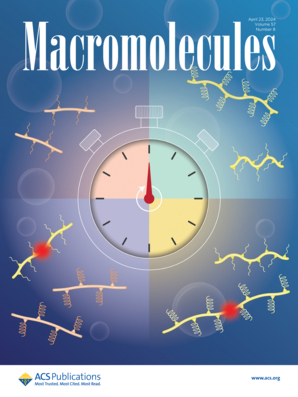光介导原子转移自由基聚合在水中开容器和可扩展合成线性和支链聚(甲基)丙烯酸
IF 5.2
1区 化学
Q1 POLYMER SCIENCE
引用次数: 0
摘要
采用常规自由基聚合法(FRP)大规模合成了聚甲基丙烯酸(PMAA)和聚丙烯酸(PAA)。FRP对建筑多样性的影响有限,但可以通过可逆失活自由基聚合(RDRP),包括原子转移自由基聚合(ATRP)来解决。甲基丙烯酸(MAA)和丙烯酸(AA)的ATRP是具有挑战性的,因为第二羧酸阴离子(CO2 -)通过卤化物(X)端基的位移和链端功能的丧失而发生内酯化。尽管使用各种RDRP方法成功地聚合了MAA或AA ((M)AA),但(M)AA的耐氧光atrp尚未得到研究。本文通过在聚合混合物中加入丙酮酸钠(SP)或丙酮酸(PA),实现了(M)AA在开瓶中的光- atrp。光照射SP/PA产生自由基,提高了室温下的聚合速度,减少了内酯化反应。该方法可在低pH(1 ~ 3.2)条件下合成PMAA或PAA (P(M)AA),分散性较低(优化条件下Đ = 1.10-1.38),理论分子量(Mn,theo)与绝对分子量(Mn,abs)吻合较好。photoatrp可以在≤1 h内合成PMAA,也可以与α-卤代丙烯酸共聚合成支链PAA。此外,在分散的水介质中成功地实现了聚偏氟乙烯-共氯三氟乙烯(PVDF-co-CTFE)的MAA接枝。本文章由计算机程序翻译,如有差异,请以英文原文为准。

Open-Vessel and Scalable Synthesis of Linear and Branched Poly(meth)acrylic Acid via Light-Mediated Atom Transfer Radical Polymerization in Water
Poly(methacrylic acid) (PMAA) and poly(acrylic acid) (PAA) are synthesized on a large scale by conventional free radical polymerization (FRP). The access to architectural diversity by FRP is limited but can be addressed by reversible deactivation radical polymerization (RDRP), including atom transfer radical polymerization (ATRP). ATRP of methacrylic acid (MAA) and acrylic acid (AA) is challenging due to lactonization via the displacement of halide (X) end groups by penultimate carboxylate anions (CO2–) and the loss of chain-end functionality. Despite the successful polymerization of MAA or AA ((M)AA) using various RDRP methods, the oxygen-tolerant photo-ATRP of (M)AA has not yet been investigated. Herein, photo-ATRP of (M)AA in open vials was enabled by adding sodium pyruvate (SP) or pyruvic acid (PA) to the polymerization mixture. Photoirradiation of SP/PA generated radicals and enhanced the rate of polymerization at ambient temperature, which diminished lactonization reactions. This method allowed the synthesis of PMAA or PAA (P(M)AA) at low pH (1 to 3.2) with relatively low dispersity (Đ = 1.10–1.38 under optimized conditions) and good agreement between the theoretical molecular weight (Mn,theo) and the absolute molecular weight (Mn,abs). Photo-ATRP allowed the synthesis of PMAA in ≤1 h and also the synthesis of branched PAA by copolymerization with α-haloacrylic acids. Additionally, successful grafting of MAA from poly(vinylidene fluoride-co-chlorotrifluoroethylene) (PVDF-co-CTFE) was achieved in dispersed aqueous media.
求助全文
通过发布文献求助,成功后即可免费获取论文全文。
去求助
来源期刊

Macromolecules
工程技术-高分子科学
CiteScore
9.30
自引率
16.40%
发文量
942
审稿时长
2 months
期刊介绍:
Macromolecules publishes original, fundamental, and impactful research on all aspects of polymer science. Topics of interest include synthesis (e.g., controlled polymerizations, polymerization catalysis, post polymerization modification, new monomer structures and polymer architectures, and polymerization mechanisms/kinetics analysis); phase behavior, thermodynamics, dynamic, and ordering/disordering phenomena (e.g., self-assembly, gelation, crystallization, solution/melt/solid-state characteristics); structure and properties (e.g., mechanical and rheological properties, surface/interfacial characteristics, electronic and transport properties); new state of the art characterization (e.g., spectroscopy, scattering, microscopy, rheology), simulation (e.g., Monte Carlo, molecular dynamics, multi-scale/coarse-grained modeling), and theoretical methods. Renewable/sustainable polymers, polymer networks, responsive polymers, electro-, magneto- and opto-active macromolecules, inorganic polymers, charge-transporting polymers (ion-containing, semiconducting, and conducting), nanostructured polymers, and polymer composites are also of interest. Typical papers published in Macromolecules showcase important and innovative concepts, experimental methods/observations, and theoretical/computational approaches that demonstrate a fundamental advance in the understanding of polymers.
 求助内容:
求助内容: 应助结果提醒方式:
应助结果提醒方式:


